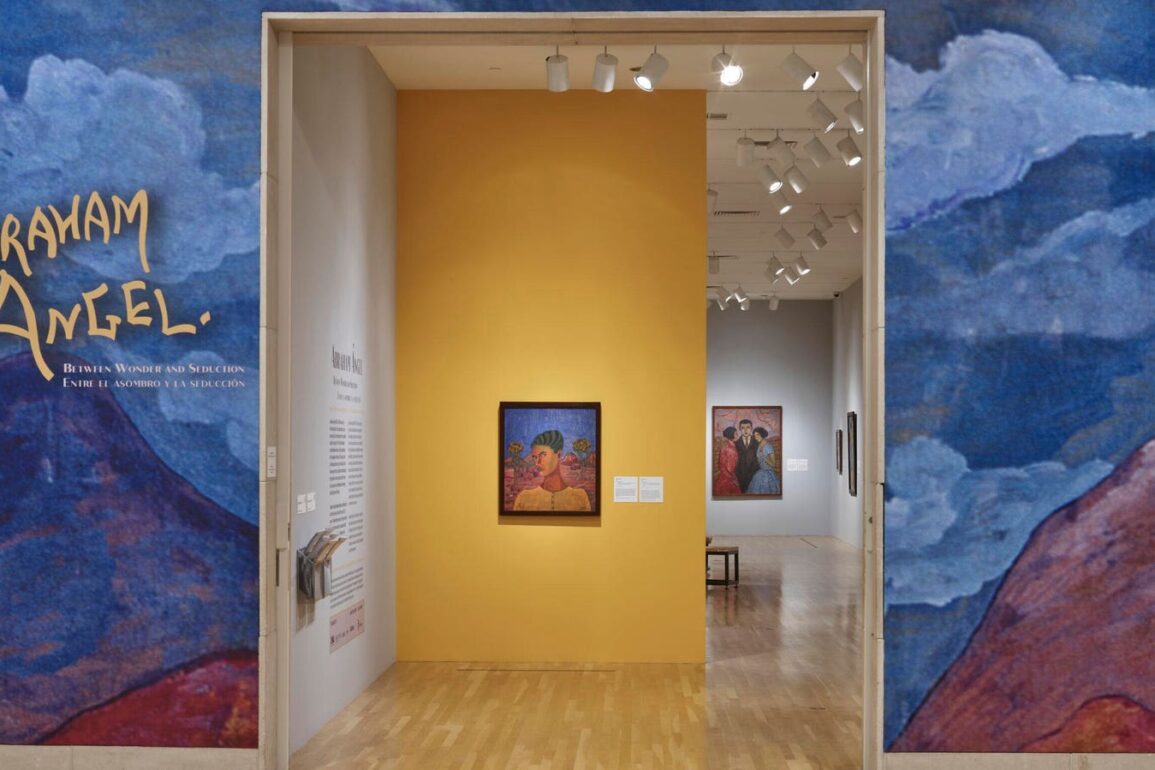
A shooting star streaks across Mexico City illuminating its most vibrant moment.
The Mexican Revolution had just ended. The yoke of European colonization thrown off. Independent Mexico was finally free to revel in its mexicanidad, its “Mexicanness.” The great city was buzzing. The country was modernizing.
Abraham Ángel (1905–1924) was painting.
He was the shooting star–brilliant, breathtaking, brief.
Painfully brief.
In a singular artistic style developed as a teenager over a career lasting a mere three years, Ángel successfully captured the rapidly changing society and culture of Mexico City in the 1920s. Twenty-four paintings was all it took for him to achieve immortality, to establish himself as a legendary figure in the canon of modern Mexican art.
The giant of Mexican modernism, Diego Rivera (1886-1957), spoke reverentially of Ángel following his death, saying, “there was nothing in the life of this young man that was not beautiful, and his painting was his life.”
The lasting and luminous tail of Mexico’s shooting star can be seen now through January 28, 2024, at the Dallas Museum of Art during “Abraham Ángel: Between Wonder and Seduction,” the first dedicated showing of his paintings in the United States. The exhibition takes its name from Luis Mario Schneider’s book on Ángel published in 1995.
“He described seeing Ángel’s painting for the first time as an experience somewhere ‘between wonder and seduction,’” exhibition curator and the Dallas Museum of Art’s former Jorge Baldor Curator of Latin American Art Mark A. Castro told Forbes.com. “My first experience seeing the artist’s work felt the same and I wanted to capture that sensation in the title, as well as honor Schneider for his important work.”
“Brutal reality destroyed him”
Abraham Ángel, ‘Portrait of Manuel Rodríguez Lozano’ / ‘Retrato de Manuel Rodríguez Lozano,’ 1922, … [+]
As happens when the especially gifted die especially young, Ángel was remembered by his contemporaries in near messianic terms. Not just by Rivera. Painter Manuel Rodriguez Lozano (1896–1971) wrote shortly after Ángel’s death that, “brutal reality destroyed him.”
“(The quote) expressed in such raw terms how Rodríguez Lozano and many others felt about Ángel’s death–that he was almost too unique and talented to survive the brutality of the real world,” Castro said.
Lozano wasn’t just Ángel’s mentor, they were lovers. One of the brutal aspects of their real world was its homophobia. Mexico may have been modernizing, but it wasn’t that progressive.
“We know that mainstream Mexican society in the 1920s was hostile to queer people; there are documented cases of arrests, persecution, and discrimination. For Ángel, we don’t have specific details about his experiences, but there are things we can infer,” Castro explains. “Most notably, not long after his relationship with Rodriguez Lozano began, Ángel left his family home at age 16 and stopped using his family name, ‘Card,’ instead going by his first and middle names, ‘Abraham Ángel.’ Although some scholars suggested this break was due his older brother–who was head of the family–not approving of him being an artist, I think we could deduce that Ángel’s choice to pursue a romantic relationship with a man was also a significant factor.”
With only two dozen paintings to his name–four of them lost–discerning Ángel’s sexuality from a reading of his works proves tricky, but not impossible.
“Ángel’s sexuality is not front and center in all his works, but there are several paintings where I think it feels particularly palpable,” Castro said. “The Cadet, for example, shows a young military cadet walking down a nighttime street in Mexico City, the collar of his jacket flipped up around his chin. To those in the know, this painting would have evoked the experience of cruising for romantic encounters on the capital’s streets, using their coat collars to shield their identity from prying eyes. In other works, the connection feels more subtle; many of Ángel’s paintings gesture to the lives of young people living a kind of Bohemian lifestyle in the capital which were the kind of social networks where being queer would have been embraced.”
Abraham Ángel, ‘Self-Portrait’ / ‘Autorretrato,’ 1923, oil on cardboard, 31 7/8 x 28 1/4 in. Museo … [+]
Ángel’s magnificent 1923 self-portrait, on view in the show, may offer another glimpse of the artist taking on his sexuality and identity. Regarding the painting without knowledge of the artist or its title, the subject appears female. At the very least as much female as male.
Photographs of Ángel at the time reveal soft, feminine features, but not unusually so for an attractive 18-year-old. The self-portrait plays up his femineity.
“Tapping into the capital’s emerging queer subculture, Ángel’s work asserted his own identity and in doing so carved out space for future queer artists in Mexico,” Castro said.
Specific to Self-Portrait (1923), Castro notices something else.
“I’m always struck by the confidence of this painting,” he said. “Ángel depicts himself looking boldly out at his viewers, his face tilted slightly away so that his eyes give us an almost challenging sideward glance. When it first clicked for me that he had painted this when he was 18, I was blown away–how could someone so young evoke such sense of confidence?”
A prodigy on the order of Picasso or anyone else from art history who painted with the maturity of a master before they could grow a beard. It bears repeating that at 17, 18, 19-years-old, Ángel was in the thick of the city’s cultural scene at one of the most dynamic moments in its history. The arts were seen as essential to Mexico’s post revolution reconstruction and he proved to be one of its leading and lasting figures.
“In some cases, I think we conflate quantity with quality; it is possible to be a hugely prolific artist and still produce works that have little merit, and of course the opposite is also true–there are artists who produce very little, but each work has a significant impact,” Castro said. “Perhaps a better metric to think about in Ángel’s case is longevity; in the almost hundred years since his death, he remains one of the key figures in the history of modern Mexican art. He achieved with 24 paintings what some artists are unable to accomplish with 2,400.”
The Mexican art world was shocked when Ángel died suddenly at age 19. He was found in his bed. Cocaine overdose. Was it intentional or accidental? No one can be sure. Was it the result of a breakup with Lozano or simply “brutal reality” that destroyed him?
“The painter of Mexico City”
Installation view of ‘Abraham Ángel- Between Wonder and Seduction’ at the Dallas Museum of Art.
“The painter of Mexico City.” That’s how Rivera remembered Ángel.
The icon may simply have been referring to Ángel’s focus on urban subjects; Castro finds Rivera’s statement more complex.
“On the one hand, Ángel’s paintings evoke some of the changes that were sweeping Mexico City and its surrounding region in the 1920s–the capital was expanding and modernizing at a tremendous rate, with new roads, buildings and infrastructure going up. At the same time, I think Rivera is also gesturing to the ways in which Ángel’s works capture the social changes that were transforming Mexico City,” Castro explains. “This was the era of the new ‘modern Mexican woman,’ who were increasingly visible in the workforce and leading lives independent of domestic life. Queer people, like Ángel himself, were also emerging from society’s shadows, and while they may not have found widespread acceptance, the existence of their identity was not quite as taboo as it once was.”
“Between Wonder and Seduction” displays Ángel’s paintings alongside a selection of works by his contemporaries, including Lozano, contextualizing his artistic practice within the broader narrative of Mexican modernism.
“His art embodies joy and vivacity while tracing Mexico’s transformation from rural to modernized,” Agustín Arteaga, the DMA’s Eugene McDermott Director, said. “This exhibition reveals to the world the artistic qualities which had no precedent and no comparison within his times. Ángel’s life story continues to resonate, and his art will captivate audiences of today as it did a century ago.”
Visitors to the exhibition will see the work of a young artist exploring the intersections between national and personal identity through the natural environment, Indigenous cultures, and urban life. Bold, emotional paintings revealing a colorful imagination belying his age.
Ángel was undoubtedly an extreme talent and his 24 works made a substantial impression on Mexico’s leading cultural figures at the time. Still, for so few pieces to have such an immense impact, something greater must be at work.
“For many, Ángel represented the first of a new generation of Mexican artists who was coming of age after the Mexican Revolution and developing their art without the influence of European academic traditions,” Castro surmises of Ángel’s outsized legacy relative to his sparse production. “It wasn’t just Ángel they lost, but the hope he represented for a new type of Mexican art and culture.”
“Abraham Ángel: Between Wonder and Seduction” is accompanied by the first English-language publication on the artist. After leaving Dallas, the exhibition travels to the Museo de Arte Moderno, Mexico City, where it will be on view from March 16 to July 9, 2024.
This post was originally published on this site be sure to check out more of their content








